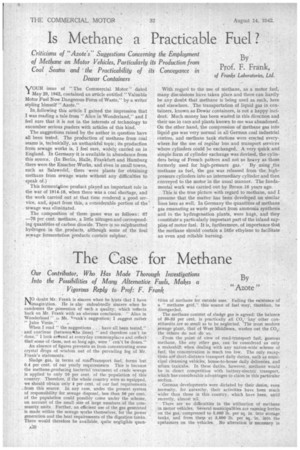Is Methane a Practicable Fuel ?
Page 32

If you've noticed an error in this article please click here to report it so we can fix it.
Criticisms of " Azote"s" Suggestions Concerning the Employment of Methane on Motor Vehicles, Particularly its Production from Coal Seams and 'the Practicability of its Conveyance in Dewar Containers
By Prof. F. Frank,
of Franks Laboratories, Ltd.
YOUR issue of " The Commercial Motor" dated May 29, 1942, contained an article entitled "Valuable Motor Fuel Now Dangerous Form of Waste," by a writer styling himself " Azote."
InJollowing this article I gained the impression that I was reacting a tale from "Alice in Wonderland," and I feel sure that it is not in the interests of technology to encumber serious readers with articles of this kind.
The suggestions raised by the author in question have all been tested. The production of 'methane from coal seams is, technically, an unthankful topic; its production from sewage works is, I feel sure, widely, carried on in England. In Germany it is available in abundance from this source. (In Berlin, Halle, Frankfurt and Hamburg there were the Emscher Works, and e'ven in small towns, such as Salzwedel, there were plants for obtaining methane from sewage waste without any difficulties to speak of.)
This ferment*tion product played an important role in the war of 1914-18, when there was a coal shortage, and the work carried out at that time rendered a good service, and, apart from this, a considerable portion of the . sewage was eliminated.
The composition of these gases was as follows : 67 —70 per cent, methane, a little nitrogen and corresponding quantities of carbon dioxide. There is no sulphuretted hydrogen in the products, although some of the foul sewage fermentation products contain sulphur. With regard to the use of methane, as a motor fuel. many discussions have taken place and there can hardly be any doubt that methane is being used as such, here and elsewhere. . The transportation of liquid gas in containers, known as Dewar containers, is not a happy incident. Much money has been wasted in this direction and their use in cars and plants known to me was abandoned. On the other hand, the compression of methane gas into liquid gas was very normal in all German coal industrial centres, and methane tank stations were erected everywhere for the use of regUlar bus and transport services • w.here cylinders could be exchanged. A very quick and simple form of cylinder exchange was devised, the cylinders being of French pattern and not so heavy as those
formerly used for high-pressure gas. By using the methane as fuel, the gas was released from the _highpressure cylinders into an intermediary cylinder and then conveyed to the motor in the usual manner. The fundamental work was carried out by Bronn 16 years ago.
This is the true picture with regard to methane, and I presume that the matter has been developed on similar lines here as well. In Germany the quantities of methane gas emanating as waste product from ammonia synthesis and in the hydrogenation plants, were huge, and they constitute a particularly important part of the inland supplies of motor fuel. It is, furthermore, of importance that the methane should contain a little ethylene to facilitate an even and reliable burning.




















































